- Home >
- Featured Destinations>
- Fuji
Mt. Fuji

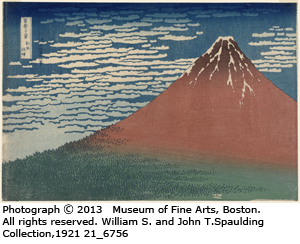
One of Hokusai's paintings
At 3,776 meters, Mt. Fuji is the highest peak in Japan. Perpetually covered by snow, its beautiful form has captivated people since ancient times and is revered and loved as a symbol of Japan. Among the works of notable Japanese ukiyo-e painter Katsushika Hokusai is the series "Thirty-six Views of Mount Fuji," which captures the beautiful shape of the mountain, popular among people of all ages.
With the goal of reaching the highest point in Japan, many visit in summer to climb Mt. Fuji. During the mountain-climbing season from July 1 to the beginning of September, the slopes bustle with people from around Japan and around the world.
Around the base of Mt. Fuji are five lakes. One in particular, Lake Kawaguchi, provides many excellent viewpoints for gazing at the mountain. In 2013, Mt. Fuji was inscribed on the World Heritage List. Enjoy the beautiful scenery that Mt. Fuji provides. It's not that far away.

Lake Kawaguchi
Saiko Iyashino-Sato Nenba (Healing Village)
Kachikachi-yama Ropeway
Kawaguchiko Natural Living Center
Kawaguchiko Muse Museum
This is the only museum in Japan that permanently displays the works of master doll maker Yuki Atae.
Itchiku Kubota Art Museum
Kawaguchiko Sarumawashi Theater
Fuji-Q Highland
This is a powerful amusement park with a full lineup of attractions worthy of Guinness World Records.
Getting to Lake Kawaguchi
Depart from Kawaguchiko Station on the Lake Kawaguchi Excursion Retro Bus or the Saiko Aokigahara Excursion Retro Bus, convenient ways to visit all the best locations of Mt. Fuji and Lake Kawaguchi. A two-day pass is also available for convenient, unlimited rides. Use it to take walks in the Lake Kawaguchi area.
Recommended Sights
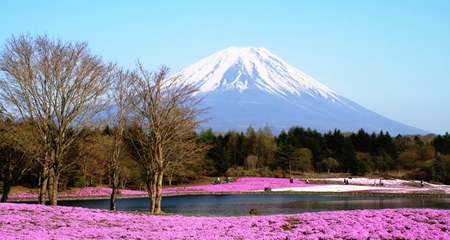 Mt. Fuji, the symbol of Japan
Mt. Fuji, the symbol of Japan
Viewing Mt. Fuji
Mt. Fuji, the symbol of Japan. Its figure is truly majestic when viewed from close up. We recommend Lake Kawaguchi as an excellent destination from the Tokyo area. Located at the base of the mountain, the lake has many great viewpoints.
From late June to early July, Oishi Park is covered in a profusion of lavender, a purple-dyed landscape for enjoying Mt. Fuji in a different way. Please remember that the actual viewing season depends on the weather.
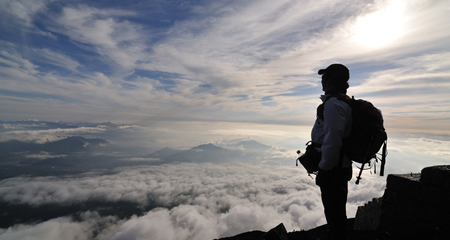 Journey to the top of Japan's tallest peak, Mt. Fuji
Journey to the top of Japan's tallest peak, Mt. Fuji
Climbing Mt. Fuji
As spectacular as Mt. Fuji is when viewed as part of the scenery, scaling its heights is a challenge everyone should take on at least once in their lifetime. The mountain-climbing season runs from July 1 to mid-September.
With many mountain cottages along the way, the Yoshida Trail starting at the fifth station of Mt. Fuji provides a sense of security and is a popular way to climb. On average, it takes approximately six hours to ascend the mountain and approximately three-and-a-half hours to descend.
(To get to the fifth station, take the Limited Express FUJI EXCURSION or transfer at Otsuki Station to the Fujikyu Railway and get off at Kawaguchiko Station. Then take the Mt.Fuji climber's bus (hiking bus) to the fifth station of Mt. Fuji.)
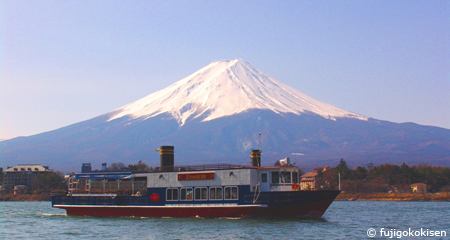 A Lake Kawaguchi sightseeing pleasure cruise
A Lake Kawaguchi sightseeing pleasure cruise
Lake Kawaguchi
In addition to many viewpoints for looking at Mt. Fuji, Lake Kawaguchi has parks, art museums, hotels, hot springs and many other facilities nearby. A sightseeing pleasure boat takes passengers on a trip around the lake to enjoy superb views of Mt. Fuji from the decks.
(To get to Lake Kawaguchi, take the Limited Express FUJI EXCURSION or transfer at Otsuki Station and take the Fujikyu Railway to Kawaguchiko Station.)
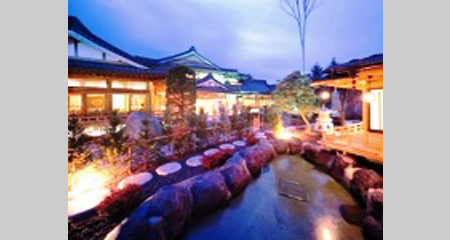 Admire Mt. Fuji's beauty from a natural hot spring
Admire Mt. Fuji's beauty from a natural hot spring
A Day Trip to the Spa
Five hot springs are located at Lake Kawaguchi: Reiho-no-Yu, Tensui-no-Yu, Reisui-no-Yu, Fuyo-no-Yu and Shurei-no-Yu. The hot spring water includes chlorides of calcium, sodium and other minerals, and is praised for curing nerve and muscle pain, poor circulation, fatigue and other ailments.
(Kawaguchiko Station, accessible on the Fujikyu Railway from Otsuki Station)
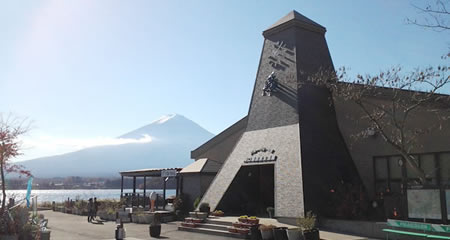 Kawaguchiko Natural Living Center
Kawaguchiko Natural Living Center
Kawaguchiko Natural Living Center
The Kawaguchiko Natural Living Center is a blueberry cultural center. Each June, the Herb Festival is held here. With a direct view of Mt. Fuji, enjoy the beautiful fields of blueberries and lavender before your eyes. A hands-on classroom is available for learning to make blueberry, rhubarb, and blueberry-raspberry jams. From the start of July to mid-August, you can also experience picking blueberries yourself.
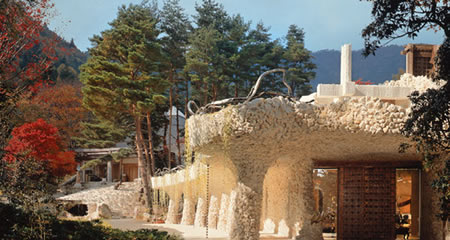 Itchiku Kubota Art Museum
Itchiku Kubota Art Museum
Itchiku Kubota Art Museum
The works of Itchiku Kubota, who perfected the Itchiku Tsujigahana dyeing technique using unique methods, are earning great acclaim in exhibits overseas as well as in Japan. In addition to the pyramid-shaped main building that exhibits representative pieces, the grounds include a gallery of glass beads (tonbo-dama) and Okinawa seashells, and a cafe and a teahouse for relaxing. Take a stroll through the gardens with views of Mt. Fuji and enjoy the beauty of nature through the seasons.
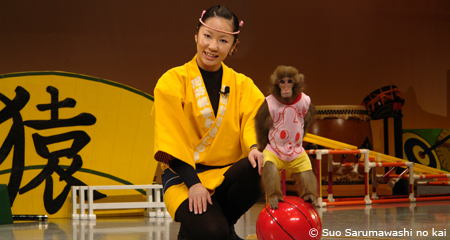 Kawaguchiko Sarumawashi Theater
Kawaguchiko Sarumawashi Theater
Kawaguchiko Sarumawashi Theater
Kawaguchiko Sarumawashi Theater has a large capacity, holding up to 650 people, and is a recommended sightseeing stop for tourists and locals alike. "Sarumawashi" means "monkey performance," a traditional Japanese art practiced for a thousand years. The impressive show has a lot of repeat visitors who come back to see it again. The monkeys are so cute, it is a highly recommended stop.
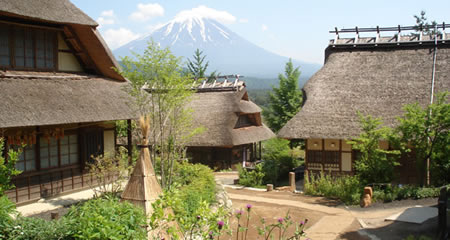 Saiko Iyashino-Sato Nenba (Healing Village)
Saiko Iyashino-Sato Nenba (Healing Village)
Saiko Iyashino-Sato Nenba (Healing Village)
To recreate a traditional Japanese village with thatched-roof houses, an archetypical image of Japan, about 20 homes were built in Saiko Iyashino-Sato Nenba (Healing Village). Inside each house is a traditional craft that you can practice yourself, there are archives and gallery to browse, shops carry local goods, and there are restaurants and cafes to explore.
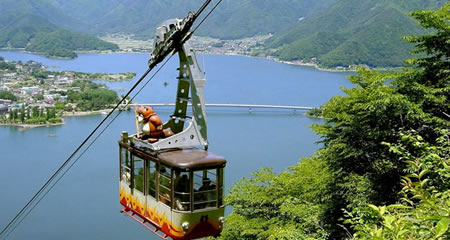 Kachikachi-yama Ropeway
Kachikachi-yama Ropeway
Kachikachi-yama Ropeway
The Kachikachi-yama Ropeway is the scene of "Crackling Mountain," a story by Osamu Dazai, one of Japan's literary masters. In remembrance of the tale, raccoon dog and rabbit dolls are arranged on the gondola and around the observatory, welcoming visitors. At an altitude of 1,075 meters, the observatory gives a complete view of Mt. Fuji and Lake Kawaguchi, making it the perfect location for sightseeing.
Local Cuisine
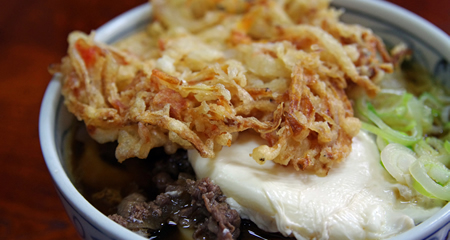 Yoshida udon
Yoshida udon
Yoshida udon
Fujiyoshida city is the home of Yoshida udon, a thick, handmade udon with lots of body. More than 50 udon shops line the streets, selling this popular dish. Each location has a different flavor, and seeking out your favorite shop is a fun, gourmet way to experience the town.
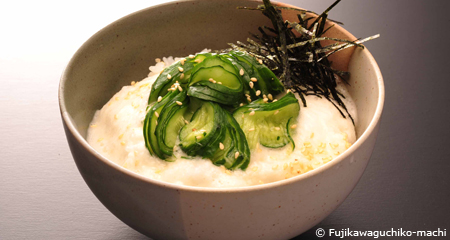 Kappa meshi
Kappa meshi
Kappa meshi
Kappa meshi is a dish of pickled cucumber, nagaimo yam, finely chopped nori and sesame served on rice. Named for the mythical kappa believed to live near water, kappa meshi has become a popular dish in the Lake Kawaguchi area. People find the light, simple taste has them wanting seconds (and thirds). Approximately 50 locations near Lake Kawaguchi offer this wonderful dish.
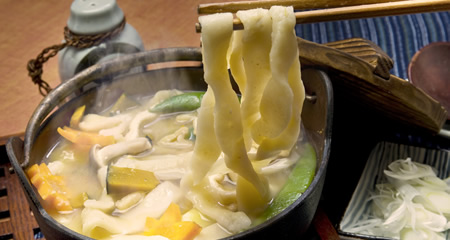 Hoto
Hoto
Hoto
The local cuisine of Yamanashi is made from flat noodles, and lots of fresh vegetables including kabocha squash simmered in a miso broth. During the Warring States period (the sixteenth century), the military commander Takeda Shingen is said to have selected it as the food for his troops, and there is no doubt that it kept their bellies full.
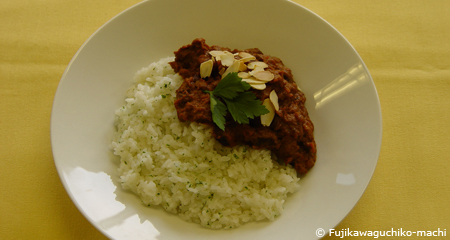 Wild game
Wild game
Wild game
An approach to cooking growing in popularity these days is the use of wild game. Deer curry, a specialty of Lake Motosu and Lake Shoji, is lighter in flavor than beef, and higher in protein while having fewer calories, a great combination.
Mt. Fuji at a Glance
Location
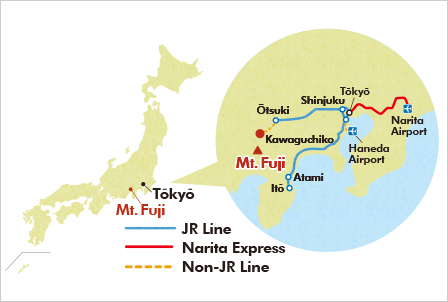
Access
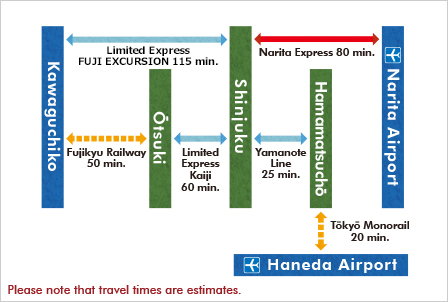
- Days needed: 1–2
- Approximately 1 hour 50 minutes from Shinjuku to Kawaguchiko Station. Board the Limited Express "Kaiji" to Otsuki then transfer to the Fujikyu Railway to Kawaguchiko Station.

